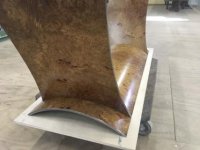We knifemakers spend a lot of time on this, and have done tons of tests with various non-metal adhesions to steel, and other metals.
The short answer: West Systems G-Flex, Acraglas, or Loctite Speedbonder 324/326, depending on application. These are by far, the best adhesives on the market, without getting into highly specialized app specific adhesives that there's little to no public info on.
If your parts will be subject to a lot of flex or material movement, G-Flex may work best.
Acraglas is the primary adhesive used by professional high end gunsmiths for bedding rifle barrels in wood stocks. It's tougher than G-Flex in rigid applications.
Both Acraglas and G-Flex are two part epoxies, and 24 hour cure times. As a general rule, the longer the cure time, the stronger the glue. 5 minute epoxies for example, are all universally low strength and really not suitable for long term, critical bonding.
Loctite Speedbonder is an acrylic anaerobic adhesive, which cures in the lack of oxygen, and it's the only acrylic adhesive I'm aware of with the strength and heat tolerance of epoxies. The advantage of these, are that 324 and 326, have 1 minute or 5 minute fixture times with much faster cure rates than the equivalent strength 24 hour cure epoxies, and the anaerobic nature, means that extra adhesive that squirts out the joint, doesn't cure hard if not removed promptly.
G-flex and Acraglas require some diligence if you're joining finished parts, as they may continue to ooze out small quantities of adhesive from the joint as the curing progresses, which isn't an issue if you have room to go back and sand/grind the joint further, but is a concern if they're completely finished parts and the last step is gluing. Cured epoxy is very difficult to remove without cutting or abrading, and can be destructive to wood especially when attempting such.
The Loctite adhesives are single part, with an "activator" or "primer" that is brushed or sprayed on one or both parts before hand, which causes the fixture and cure times to line up with the stated numbers, and requires slightly different technique than epoxy.
All of these, material prep is extremely critical. Clean solvent clean up before gluing, and proper surface finish (coarse finishes to the level acceptable that wont show gaps or lines at a joint, are better, and help especially where adhesives all have weakness, in peel), and for critical bonds, relief cuts that allow better adhesion where you can hide them, are better.
Personally, I've gravitated toward the Loctite adhesives for my work (high end pocket knives, slipjoints primarily), but I previously used both Acraglas and G-Flex with good results, joining steel and other metals to wood, ivories, phenolics, bone, horn, etc.
All that being said, it's always advantageous to add a mechanical fastener when possible, and it almost always is. Blind or hidden pins (rivets) that don't show on the presentation faces are an option, or domed pins of a different material that have hand formed heads which can show hammer marks or be polished perfectly round, are a great option, that not only add strength, but character and value to the work, are worth considering.



